
E-mail: font@focusonnature.com
Phone: Toll-free in USA 1-888-721-3555
or 302/529-1876
 |
PO
Box 9021, Wilmington, DE 19809, USA E-mail: font@focusonnature.com Phone: Toll-free in USA 1-888-721-3555 or 302/529-1876 |
THE FOCUS ON NATURE TOUR IN BRAZIL
March 2008
with
Bobolinks, and many, many other birds:
especially notable: a rare Merganser, a rare Eagle,
and a non-bird, a rare Sloth
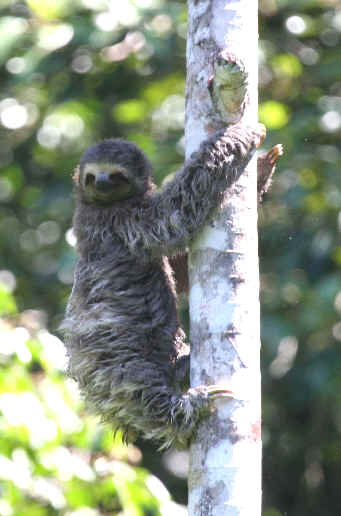
This rare animal, a Maned Three-toed Sloth,
was photographed during the FONT Brazil Tour in March 2008
(photo by Marie Gardner)
Links:
List of Birds during our Brazil Tour - March 2008
A Photo Gallery of Nature & Scenery from the FONT March 2008 Brazil Tour
A List
& Photo Gallery of Brazil Birds, in 3 parts:
Part
#1: Tinamous to Doves Part #2: Macaws to Flycatchers
Part #3: Antshrikes to Grosbeaks
Birds in Minas Gerais Birds in Mato Grosso do Sul Birds in Southeast Brazil
Rare Birds during FONT Tours in Brazil (with some photos)
Mammals & Other Wildlife during FONT Brazil Tours (with some photos)
Upcoming FONT Birding & Nature Tours in Brazil

The FONT Brazil March '08 Tour
Group
having dinner one evening during the tour
The following narrative was written by Armas Hill, leader of the tour:
"In Brazil, with
Bobolinks, and many, many other birds
- and especially notable for us: a merganser, an eagle, and a non-bird, a
sloth"
We were in Brazil
when Bobolinks were, during our tour of March
6-18, 2008. Prior to the tour, a total of 1,031 different birds had
cumulatively been seen during FONT birding & nature tours in Brazil. The Bobolink
was our only "new" species for the country during our March '08 tour,
which was the 42nd FONT tour in Brazil.
During the tour, we traveled in the southeast Brazil
(Sao Paulo state), Minas
Gerais, and Mato Grosso do Sul.
Our last few days were back in Sao Paulo state,
mostly along the beautiful seacoast, in the area of Ubatuba.
Bobolinks, when they are in North America, are sometimes called "Ricebirds",
as when they're migrating south from where they breed, they are fond of rice
fields in southern US. Where they breed are grassy fields in the northern US and
Canada. Where we saw some, during our March 2008 tour in Brazil, was in an area
of rice fields in Mato Grosso do Sul, in a
general area known as the Pantanal. The Bobolinks,
when in Brazil, have another name there, being called locally "Triste-pia".
The species arrives in Brazil late in the year in its non-breeding plumage,
looking somewhat like a sparrow. During its stay in Brazil, it undergoes a full
molt from January to March, before the male acquires its nuptial dress of black,
white, and yellow. Some Bobolinks that we saw in the Brazilian fields in
March were fairly well along into that plumage.
The Bobolink makes one of the longest annual migrations of any American
landbird, covering over 20,000 kilometers during its yearly round-trip. That's
somewhat similar to the distance that most of us, in our group, traveled to and
from Brazil. A participant from Florida traveled a bit less; another, from
Alaska, traveled more.
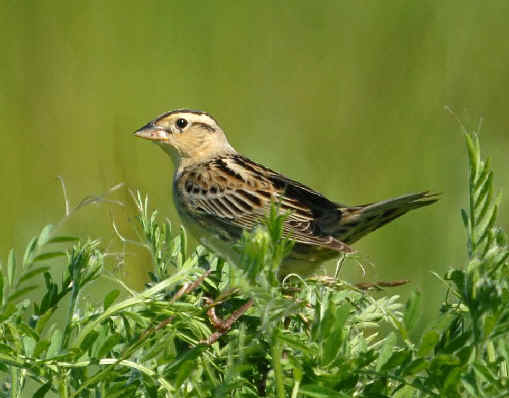
A female Bobolink
Of the many bird species that we saw during our March '08 tour in Brazil, there
were just 5 that traveled from North America, as we and the Bobolinks
did, and that would soon leave Brazil to return to North America. The other 4
species that we saw, in that select group, were: Solitary Sandpiper, Spotted
Sandpiper, Osprey, and Barn Swallow. None of these species nest
anywhere in South America.
The Bobolinks do not appear on the North American scene until May. But, Ospreys
would start to arrive at their nesting sites in North America at about the time
that we would return home from the tour. Barn Swallows and the two sandpipers
would soon follow.
As we were observing the Bobolinks in Brazil in March, the sky in that
area above the water and fields was filled with Barn Swallows, flying
about catching insects. There were hundreds of them. On reeds they gathered,
with their rich orange coloration as they were into their breeding plumage. The
next day, in that same area, there were no Barn Swallows to be seen. The groups
of them that we had seen the previous day apparently continued further north
catching insects someplace else. Brazil is a very big country, and there's a
large area for migrating birds to cover.
But even with the swallows missing, there were many, many birds where we
were in the Pantanal. We had never seen, during any tour previously, for
example, so many Picazuro Pigeons. Late in the afternoon, huge flocks of
them, generally heading in one direction, flowed as if they were a river in the
sky above us. They were quiet, but the flocks of mostly parakeets and
also some parrots, of various kinds, that flew in that late afternoon sky
were certainly noisy indeed.
The pigeons and parakeets were going from one grove of trees to
another. As we traveled along a dirt road, each of the single big trees ahead of
us would "explode" with birds bursting out - again, pigeons,
parakeets, and parrots.
There were so many birds, of various kinds, where we were in Mato Grosso do Sul.
Not only as just described in the air and the trees, but also on fields and on
and by bodies of water. One time, during one of our morning excursions (as we
routinely did on a high, open vehicle), we could see that a green field
ahead of us was filled with big white birds. They were Jabirus, large storks
as tall as people. In that field, there were about 300 of them! Most were
adults, but some we could see were young birds of the year. We stopped and
watched, as the big birds either stood or walked about. Sprinkled in with them
were the two other American members of that family, both Maguari and Wood
Storks. They were also large, but not as big as the Jabirus.
After Greater Rheas, that we also saw when we were in Mato Grosso do Sul,
Jabirus are the largest American birds. The Greater Rhea, from the tip of
its bill to that of its tail, averages a length of 170 centimeters. For the Jabiru,
that length is 140 centimeters. For the other two Storks, the Maguari and
the Wood, that length is about 120 and 100 centimeters, respectively.
Another large bird was in the area, the Cocoi Heron. It's a cousin of the
Great Blue Heron of North America and the Grey Heron of Eurasia.
Its length, from the bill to the tail, is about 125 centimeters.
Not factored in the figures just given are the long legs had by all of the birds
just noted: the Rhea, the Jabiru, the other storks, and the
Cocoi. When they are on the ground, these birds are tall. And, thus, they
are among a number of Brazilian birds that are "big", including, for
example, the Hyacinth Macaw (the largest parrot in the
world), and the Toco Toucan (the largest in its family). The
big macaw and the large toucan were also seen during our time in
Mato Grosso do Sul (but elsewhere, just over a hundred miles to the east of
the field of Jabirus).
We were never without birds, during day or night, when we were on the large
property of the ranch, where we were with the Jabirus, Pigeons, Parakeets,
Swallows, and Bobolinks. In all, we saw well over a hundred species
of birds during our time there.
In addition to the storks, herons, and egrets, there were large
flocks of Whistling-Ducks (Black-bellied & White-Faced),
and Ibises (mostly Bare-faced, but also both Buff-necked
and Plumbeous). The Southern Screamer was about,
another big bird related to waterfowl (thus appearing rather like an
odd fat goose), as were Limpkins. There were lots of them. We saw
them, of course, but at night (all night) we could hear them, even from
our rooms, constantly wailing in the distance. As just noted, we were never
"without birds", either by day or night.
We did night-time excursions on the high, open vehicles, referred to earlier. On
two nights, we were out from two to three hours. Our weather was always good.
One night, the sky was so clear, as we were not near any light pollution, that
the stars were absolutely brilliant dazzling above us in the sky. We could
nicely see Orion (without being cold!) and an assortment of southern
constellations never visible from our homes in the Northern Hemisphere.
Closer to the ground, during the first of our two nights (the one without
clouds) we had a tremendous venture with birds. The next night, the birds
were good again, but the mammals were better.
As we traveled on dirt tracks in the dark, either by waterways, or fields, or
forest edge, continually there were nightjars. Some stayed on the ground
ahead of us to be observed as a light was shone on them. Others were flying
about. Again and again, we saw Little and Scissor-tailed Nightjars,
and Pauraques. A couple times, we stopped to observe Common Potoos
that sat still on exposed branches. One, close to us, was at about our eye
level, and its large eyes took notice of us as ours watched it. We saw owls,
nicely, notably Striped and Barn Owls.
Whistling Ducks actively feed at night. We heard them whistling, as we
heard the Limpkins, already referred to, wailing.
A couple Brazilian Teals, one night, were crouched down on the dirt road.
Reluctantly they moved, keeping low to the ground, as our vehicle approached
them.
During the day, we saw, of course, some Southern Lapwings here and there.
After dark, however, along the dirt roads, a few times, we encountered large
flocks of them roosting, with what seemed to be more a hundred birds at once. As
the vehicle got near them, they lifted up into the air, flying about like light,
but noisy, ghosts. In fact, they raucously called as they flew about. Such a
flock of Lapwings sounds rather like a colony of North American Laughing
Gulls when they're at their noisiest.
And there were mammals seen during our excursions after dark on the high,
open vehicles. During our tours in previous years, at the same ranch, we've seen
a great assortment of animals, with looks, twice in the past, at Jaguar.
Two were seen a day or two before our March '08 visit.
Unfortunately, we did not encounter a Jaguar during either night in March '08.
But that's OK. A great effort was made in that regard, and we did see some other
nice mammals and, as noted, many birds. It should be noted that the spotters who
look, with their lights, for the animals and birds, are very, very good, and
thus, where we were has been one of the best places of any that we go, to see
the creatures of the night.
During both nights, in March '08, we saw Ocelots. The first night we saw
one - quickly. The second night we saw 3. Seeing one of them, in particular, was
a wonderful sighting as the beautiful animal walked back and forth, a few times,
on the road just ahead of us. Other mammals that we saw after dark were two with
the adjective "Crab-eating", the Fox and the Raccoon.
We also saw a couple Tapitis (or Forest Rabbits), an
animal not commonly seen, and deer: the Red Brocket Deer, and the Marsh
Deer. And, of course, there were Capybaras. They, and the Marsh
Deer, we also saw during the day, along with the Gray Brocket Deer.
At dusk, we saw the Six-banded Armadillo. Among the bats, during
our nocturnal excursions, the most obvious were the reddish-colored Lesser
Fishing Bats, flying about with the nightjars. It was that those
night-time fliers never collided. There were so many.
While on the subject of mammals, mention should be made, now, that
elsewhere during our tour, we encountered 2 Jaguarundis (another
species of wild cat), and a Paca (an agouti-like animal, but with
spots, and active only at night).
The Ocelots, just noted, were tremendous. But, before we were to go home,
the mammal of the tour that was the most unexpected was one that found during
the day, in the Atlantic Forest of Coastal Brazil. It was the rare and
endangered Maned Three-toed Sloth. More will be said about it later in
this narrative.
But let's go back now to Mato Grosso do Sul,
as some more needs to be said about what we saw there.
Reference has already been made to "big birds". There were others in
that department. One morning, not far from a river, were saw Bare-faced
Curassow, Rusty-margined Guan, and Chaco Chachalaca, all of them big
enough. The last of these can also be noisy.
It's more usual for tinamous to be heard during a tour than seen. During
our March 2008 Brazil tour, we did hear Undulated Tinamou in Mato Grosso
do Sul and Spotted Nothura in Minas Gerais, and later, in the Atlantic
Forest, the Brown Tinamou.
But also, in Mato Grosso do Sul, we SAW a tinamou that we never did hear.
As we were driving along a dirt side-road, one afternoon, a Small-billed
Tinamou walked, slowly but with some determination, across the road in front
of us.
Why did it "cross the road"? Apparently, we figured, simply to get to
the other side.
Nearly always, during our tours in Brazil, we see the Squirrel Cuckoo,
and usually if we don't see a Striped Cuckoo, we hear one (or more
often, more than one). But, during our March '08 Brazil tour, oddly, we
never encountered either, but both the Little Cuckoo and the Ash-colored
Cuckoo were seen, both during one morning in Mato Grosso do Sul. The Little
Cuckoo was our first since 2005, and the Ash-colored our first since
2000.
Nothing has been said yet about raptors. We saw many. Caracaras were
seen many places. In Mato Grosso do Sul, numerous Lesser Yellow-headed
Vultures were at the ranch, where also there were numbers of Snail Kites,
Savanna and Black-collared Hawks, Great Black Hawks, and a couple Aplomado
Falcons.
Other Falcons that we came across elsewhere in Mato Grosso do Sul (further
east), were the Laughing and the Bat. They were perched, for
us, in an area that we visited in order to see the Hyacinth Macaw.
In fact, the pair of Bat Falcons that were there stayed tamely on snags
near us, rather unaffected by our presence, during our entire time in the area.
We were at a place with high cliffs where, in the past, we've seen Hyacinth
Macaws, a species that is, of course, one of our prime targets during a tour
in that part of Brazil. It's a spectacular bird, the largest of the world's
parrots, and an endangered species. Nesting on the cliffs occurs, according to
the books, from July to December. Yes, we were there in March, but the birds do
stay in that general area, according to the locals, year-round.
We did not see the spectacular and sought macaw at the cliff.
But we did meet one of "those locals" who was anxious to take us to a
"secret spot of sorts", where he liked to fish on a riverbank. He told
us that later in the afternoon, Macaws, including the Hyacinth,
would fly by in the sky.
We accompanied him to that spot by the river, going past a locked gate, parking
the vehicle, and then walking down to the riverside. And so that nice afternoon,
we found ourselves at a rather beautiful and wild place. Our new local friend
told us that there were Jaguars on the other side of the river. There
probably were. We did see a Blue-crowned Trogon on the other side sitting
stoically in a tree, and an Amazon Kingfisher and White-winged
Swallows flew back and forth above the water.
Then, against the backdrop of a blue sky, that afternoon, the big macaws
did fly, as promised, calling loudly as they did, either in pairs or in small
groups. Thus, we had wonderful looks at both Blue-and-yellow and Red-and-green
Macaws. In all, our count of those macaws in flight that afternoon
was about 20.
But we didn't see the Hyacinth. As we were leaving the place, there was a
different loud call of a macaw. Some of us then saw a big blue Hyacinth
fly by over the trees.
A bit later, further down the highway, 3 more Hyacinth Macaws flew by in
front of us, on their way into a large tree out in a big field to spend the
night. As that day was ending, all of us had seen our targeted bird, the big,
rare Hyacinth Macaw!
Before the portion of our tour in Mato Grosso do Sul, we were in the Brazilian
state of Minas Gerais. Over the years, that
has been one of our favorite regions of Brazil in which to travel and bird. As
good as Mato Grosso, and the Pantanal is (and it is good!), Minas Gerais
can be just as good, especially some extraordinary areas that we visit, with not
many people, and particularly for some very special birds, such as the extremely
rare Brazilian Merganser. An effort to see it is always what can be
described as a quest!
And that we did again during our March '08 Brazilian Tour.
Prior to March 2008, we had seen the rare Brazilian Merganser during 5
FONT tours, having tried for it during 6. It has been stated here twice that the
bird is rare. It is. In fact, it is one of the rarest birds in the world. Some
say that the total population of the species is about 100 pairs. Some say,
however, that number is too high.
In the mid-20th Century, the bird was thought to be extinct. It was re-found in
1948.
Why the Brazilian Merganser even exists is a bit of a mystery. All of the other
members of the Mergus genus are far away from Brazil, and well
north of the Equator.
The Common Merganser is common, across much of the Northern Hemisphere,
as is the Red-breasted Merganser.
The Chinese, or Scaly-sided Merganser is rare, but not as rare as
the Brazilian Merganser.
There was another member of the Mergus genus in the Southern
Hemisphere that is presumed to be extinct. It is (or more aptly was) the Auckland
Island Merganser of that island in New Zealand. It was rare when it was
"discovered" by naturalists in 1839, having suffered at the hands of
the Maoris who hunted it. The last of 20 existing specimens was collected in
1902. Several searches have been conducted since, with no positive results.
But as to the Brazilian Merganser, some things need to be taken into
account when searches, such as ours, are made for it. Firstly, it is very
localized, occurring only where the water of streams is clear. In those waters,
the bird feeds on small fish. Secondly, it is shy. The bird is not easily seen
where there is human disturbance.
We went to one the right places along a river, near the Serra
da Canastra National Park. One of us, when on a large rock by the
river, quickly saw one bird, gray, with white on its wings, fly rapidly
downriver from below the boulder.
Later, after a nice lunch of local food at a small country restaurant, we went
to a private spot elsewhere along the river, well away from the road, where, we
were told that late in the afternoon, the merganser would come. It did, but only
a glimpse was had as it rapidly flew, as it was getting dark, to where it would
spend the night, apparently in trees hanging over the river's edge.
We were, that day, along a stretch of river below a high cliff. Above, on a very
large plateau, there was the national park, which was an extensive area of
natural grassland.
The river spilled over the edge of the plateau in a spectacular high waterfall,
one of 26 waterfalls around the periphery of the park. The region is about as
wild and remote as just about any in Brazil, and it is beautiful.
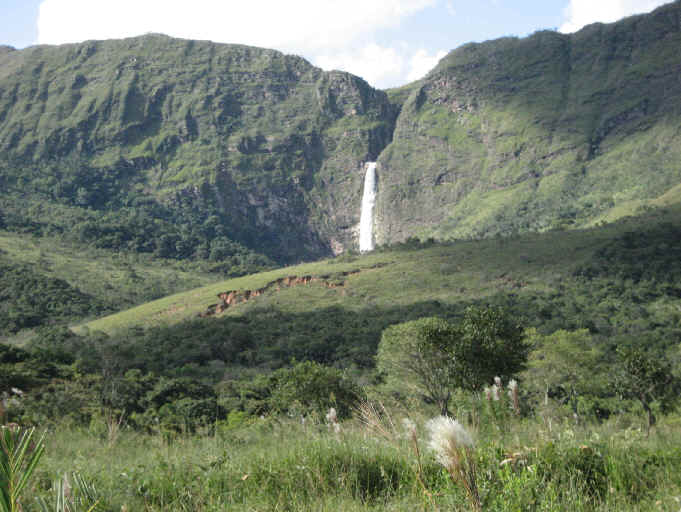
One of the
waterfalls in the wild and scenic area of Serra da Canastra National Park.
We saw Brazilian Mergansers both above and below this waterfall.
(Photographed during the March '08 FONT Brazil Tour by Sally Brady)
We spent the next day atop the
plateau in the park, but that day, even though we saw a number of birds, there
were, for us, no merganser sightings.
So, the following morning, we went early, back up into the park, to a spot with
pools of clear water and little fish, where the small river is about to spill
down into that waterfall above where we had been, and quickly saw the mergansers,
a couple days earlier. We sat in the vehicle, and waited, watching the water. It
was yet another beautiful, and a very quiet spot. Only we were there. But
unfortunately, a wall of fog came up from the waterfall and shrouded the area.
We continued to wait, but unable to see the pool that had become invisible in
the fog. The fog drifted away, but it soon came back. In the interim, the water
was still and empty. The fog then slipped away again, and then, swimming in the
water, the birds were there! Like gray phantoms, on the surface of the water,
they dove, coming up a bit later to left of where they had been. There were two.
There was one more similar look of what was either a third bird, or one of the
two just seen.
Then the fog rolled in again. Before it left, the birds must have swam up the
narrow river and around the bend. When the fog lifted at last, the still water
was empty and continued to be until we left.
But we had seen, in a mystical sort of way, the rare and cryptic bird that we
had endeavored to see.
Earlier here, mention was made of the Greater Rhea, a large ostrich-like
bird. In Brazil, the local name of hat flightless bird is the "Ema".
When we were in Minas Gerais, we had a number of nice encounters with another
bird that's usually on the ground. It can fly, but rarely does. That bird is the
Seriema. Or, "half an Ema". With a length of 90 centimeters,
from the tip of the bill to that of the tail, the name is appropriate, as the
corresponding length for the "Ema" is, as noted earlier, 170
centimeters.
The full name of the smaller, and odd, mostly terrestrial bird is the Red-legged
Seriema. There's another species in Argentina, with black legs.
The Seriemas are unusual birds, in their own unique family. On the
ground, they feed on lizards, grasshoppers, and the like. They often make a
rowdy call that carries far. As just indicated, rather than fly they
prefer to run, and can do so up to 40 kilometers (some say 70 kilometers)
an hour. They only fly into a tree where they may roost or nest. In that sense,
they are convergent with raptors. Actually, they appear and act rather like the Secretarybird
of Africa, which is a raptor.
Ancestors of Seriemas were around in South America a long time ago. In
Brazil, their fossils have been found from about 55 million years ago, a long
time indeed!
In another aspect, the Red-legged Seriema is unusual. It are one of only
a few birds with eyelashes.
We enjoyed our good looks at Seriemas in Minas Gerais, Brazil, in March
'08 - looks that were good enough to see those eyelashes!
In addition to the merganser, and the seriemas, there was another
outstanding species, that we saw well, during our time in Minas
Gerais, near Canastra.
When we stopped along a country road in an area with nothing but scenery and
birds, to observe and photograph some Toco Toucans on treetops and White
Woodpeckers (5 of them together), clinging to a tree trunk, we
happened to notice, a large raptor perched in another nearby tree. It was
as gray as the merganser that had occupied us the previous couple days. It had a
tuft, on its head, that was blowing in the breeze. And, yes, it was large. The
observation and the photography shifted to the big raptor. Not expected, and
certainly not as close as it was, the bird was a Crowned Solitary Eagle.
Shortly later, we realized that there were actually two of them in trees in
front of us, a pair. One, then the other, after a while, flew, with their big
wings, to trees a bit further away.
Yes, the Crowned Solitary Eagle is large. In South America, only 3
species of raptors have larger wing spans, the Andean Condor, the Harpy
Eagle, and the King Vulture. For 93 species of raptors, through the
Americas, wingspans are smaller.
The Crowned Solitary Eagle is about twice as big as the Plumbeous Kite.
The bird as been called simply the Crowned Eagle, but there's another
raptor with that name in Africa. So, the Crowned Solitarty Eagle it now
is, with the other more-northerly member of that genus, that has been known as
the Solitary Eagle, now called the Montane Solitary Eagle.
The Crowned Solitary Eagle is rare, and classified by Birdlife
International as "vulnerable". They estimate the total population of
the species to be from 2,500 to 10,000 individuals. But others say that the
lower of those two numbers is realistic.
At the end of our tour, the Crowned Solitary Eagle was voted, by the
participants, as the "top bird" of the trip. It was the only species
that received votes from every participant.
We had spent a day, as already mentioned, in the Serra da Canastra National
Park, with natural grasslands on a large plateau. The place, there, is
rather special, being, one could imagine, the ways things were before the spread
of "civilization" and widespread agriculture.
In those grasslands, where the Giant Anteater and the Maned Wolf
roam, the birding is quite different than it is other places. We watched Aplomado
Falcons fly fast, as they were meant to. At the end of the day, an Aplomado
Falcon was seen harassing a Short-eared Owl. In the twilight sky,
late that day, Least Nighthawks were observed flying about.
Probably the most notable of the grassland species that we saw was the Cock-tailed
Tyrant. We saw a few of these distinctive flycatchers. The species
has, during recent years, declined considerably, as it does best in such natural
grassland habitat unaltered by man. Many places where it used to be, it no
longer is.
The Cock-tailed Tyrant was just one of a number of birds that we saw, in
Minas Gerais and elsewhere, with the "tail" noted in its name. Others,
in the grasslands, were the Sharp-tailed Grass-Tyrant, the Stripe-tailed
Yellow Finch, and the Wedge-tailed Grass Finch.
Nearby, also in Minas Gerais, we saw the striking Streamer-tailed Tyrant.
Later, in southeast Brazil, there were the Fork-tailed Flycatcher and the
Long-tailed Tyrant.
A notable bird during our tour that seemed to be without a tail (it's
actually very short) was seen in southeast Brazil, near Ubatuba.
It's a bird that itself is very short - although its name is a bit long.
It's the Buff-throated Purpletuft. The bird, a little member of the cotinga
family, is just over 3 inches in length. We saw it perched on a tree-top snag,
as the species tends to do. Its buffy throat was quite visible as the bird
turned its small head one way, then the other, as it looked about.
That little bird is classified as "endangered", occurring at only a
very few places in a small fragmented range, only in Brazil. Literally, its
range is "a dot on a big map".
We were glad to see it, during a day when we were also glad to see some colorful
tanagers and a nifty hummingbird, also notable - known as the Saw-billed
Hermit. As we sat on the porch of an old fazenda building on the Tropic of
Capricorn, we watched the hermits feed on heliconia and other plants in bloom.
When they weren't feeding, or sitting still somewhere else, they were chasing
each other. The Saw-billed Hermit is one of the largest of the South
American hummingbirds.
Another large Hummingbird that we enjoyed seeing, whenever we did during
the tour, was the Swallow-tailed, with is long, blue tail. And, yes, it
was another one of our nice birds with "tailed" in its name.
And yet another bird that was great to see during our March '08 Brazil tour was
one that's about as brightly-colored as a bird can be. The bird, in southeast
Brazil near the South Atlantic coast, was the Scarlet Ibis,
known locally as the "Guara".
Not only was that bird, by whichever name, great to see, it's interesting that
it's even there, in that area of mangroves in Sao Paulo
state.
Further north, much more close to the Equator than to the Tropic of Capricorn,
the Scarlet Ibis occurs in Venezuela, Trinidad, and Guianas, most often
near the coast. In northern Brazil, it ranges in similar coastal habitat north
of, and just south of, the mouth of the Amazon.
That's a long distance from the coastal marshes of Sao Paulo, where there's an
isolated population of Scarlet Ibis, and where we saw them during our
tour.
Apparently, they've been there, in those Sao Paulo marshes, for a long time.
Back in about 1552, the German explorer, Hans Staden, took note of them there,
as he traveled along a coastal river at Bertioga.
During our tour in 2008, we crossed that river on a passenger-car ferry at
Bertioga. Earlier in the day, we had seen Scarlet Ibis just a few
kilometers away - as the ibis would fly.
Just over 20 years ago, in 1986, a census of Scarlet Ibis in that region
found a total of 82. About 10 years later, in 1997, and after some conservation
efforts, the total of Scarlet Ibis found in that region had increased to
575 birds, and the number has continued to be about the same since.
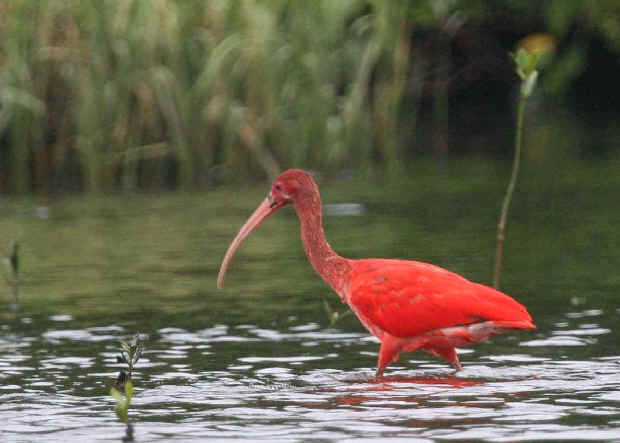
A Scarlet Ibis in southeast
Brazil,
photographed during the FONT Brazil Tour in March 2008.
(photo by Marie Gardner)
And that's it here for birds.
Now, reference will be made to what was certainly
the most unexpected sighting of our March 2008 tour in Brazil. It was when a Maned
Three-toed Sloth was found in lowland Atlantic Forest, near Ubatuba, in Sao
Paulo state, during the last day of our tour.
That mammal is a rarity, classified as "endangered". It is the
rarest of the 5 species of sloths in the Americas, and it only occurs in
eastern Brazil, in the Atlantic Forest.
Its scientific name is Bradypus torquatus. And the rare creature
was found by a lady whose last name is Brady! (Her first name is Sally.)
Not only is the species very rarely seen (it has declined considerably in
recent decades), but it was also unexpected because, according to the range
maps in books and on the internet, it occurs in lowland Atlantic Forest north of
where we saw it.
The given range is in the states of Bahia, Espirito Santo, and Rio de Janeiro,
with the stronghold of the small population said to be in Bahia (the
northernmost of those 3 states).
We saw it in Sao Paulo state, south of the state of Rio de Janeiro.
The habitat, where we saw the sloth, was right. It's said, in tropical coastal
forests, to favor Cecropia trees, and it was in one. In such a tree, the sloth,
a solitary animal, eats leaves, buds, and soft twigs. It only comes to the
ground to defecate. On the ground, it can not stand or walk. It can only drag
itself by its larger and stronger front-leg talons.
When we first saw the sloth, it was in the crown of the Cecropia tree.
Then, it slowly, yes, slowly, descended the trunk, stopping about half-way down.
That's where it was when we left it.
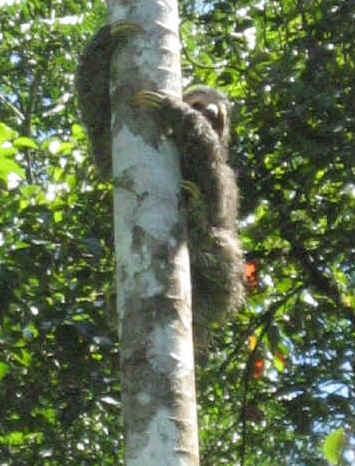
Another
photo of the rare Maned
Three-toed Sloth.
Bradypus torquatus,
clinging on the trunk of a Cecropia Tree
(this photo by Sally Brady
during the FONT March '08 Brazil Tour)
There have been, historically, more than 5 species of sloths throughout
the Americas. They were, at one time, in North America.
For example, the Giant Ice Age Sloth, Megalonyx jeffersoni,
lived in what's now Iowa, in the United States, where its claw was
"discovered" by the early US President, Thomas Jefferson. That animal
was said to stand 10 feet tall, weighing as much as 2 or 3 tons.
Finding a creature like that would have been even more unexpected for us, for
sure, but coming across a rare Maned Three-toed Sloth was exciting
enough!
The anteaters, sloths, and armadillos were previously called "Edentates".
Now, they're known collectively as "Xenarthrans". That
name means "strange joint", referring to unusual joints in backbones.
The Maned Three-toed Sloth has what could be called "wrong-way
fur", with outer hairs angled UP - the opposite direction of most animals,
so that they hang down when the sloth is in an inverted position.
A number of "Xenarthrans" - anteaters, sloths,
and armadillos - have been seen during FONT nature tours in Brazil over
the years, but the Maned Three-toed Sloth was "new" for us,
being the 69th species of mammal (excluding bats) seen
during our tours in that big, interesting, and exciting country for nature
travel.
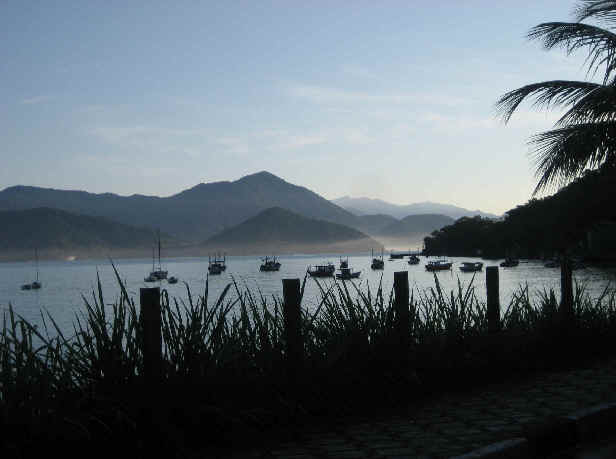
The bay,
with fishing boats, at Ubatuba. along the southern coast of Brazil.
The last place where we stayed during our March '08 Brazil Tour.
(Photo during the tour by Sally Brady)
******************************************
The following birds, from the
portions of our tour in Minas Gerais & Mato Grosso do Sul, were voted by the
tour participants as the "Top Birds" of our March '08 Brazil Tour.
Most have been mentioned in the preceding narrative.
1 - Crowned Solitary Eagle
2 - Brazilian Merganser
3 - Cock-tailed Tyrant
4 - Red & Green Macaw
5 - White Woodpecker
6 - Toco Toucan
7 - Southern Lapwing (voted for the noisy big flocks that rose
up from dirt road at night in the Pantanal)
8 - Short-eared Owl
9 - Guira Cuckoo
10 - Blue-and-yellow Macaw
11 - Jabiru
12 - Red-legged Seriema
13 - Blue-black Grassquit (voted for as the "Jumper",
doing its display on fence wires)
14 - White-rumped Tanager (a specialty of the grasslands, at Canastra)
15 - Greater Rhea (or the "Ema", as it's known in
Portuguese)